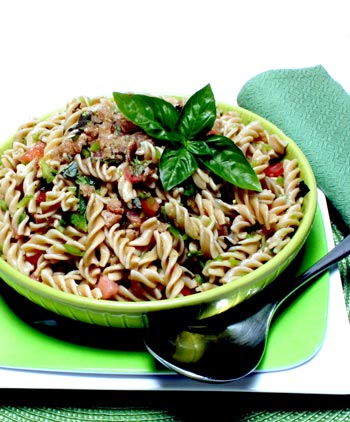Pasta Salad with Tomatoes
Few things pair more perfectly than pasta and tomatoes, and few dishes capture the feeling of summer better than cool pasta salad. Best of all, along with its great taste, pasta salad with tomatoes has good nutritional value.
The recipe calls for Roma tomatoes, though any variety will do. Roma tomatoes, also known as Italian or Italian plum tomatoes, are pear or egg shaped tomatoes that are meatier and have fewer seeds, making them a great fit for salads. Tomatoes contain the cancer protective red pigment called lycopene. The green pepper, abundant in vitamin C, provides color and its flavor combines well with tomatoes.
Tip: Experiment with the red pepper to find the level of zesty bite that appeals to your taste.
Pasta Salad with Tomatoes
(Makes 8 servings)

Ingredients
- 8 ounces whole-wheat fusilli, farfalle, or other small pasta shape, cooked according to directions
- ¼ cup balsamic vinegar (red or white)*
- 4 tablespoons finely chopped fresh basil, divided
- 1 teaspoon turbinado sugar, optional
- Salt and freshly ground black pepper to taste
- ⅛ teaspoon crushed red pepper (or to taste)
- 3 tablespoons extra virgin olive oil, divided
- 4 cloves garlic, minced and divided
- 1 medium green bell pepper, finely chopped
- 4 plum or Roma tomatoes, coarsely chopped
- 1 slice whole-wheat bread (multigrain may be substituted)
Directions
- In bowl, cover and chill pasta.
- In large mixing bowl, combine vinegar, 2 tablespoons basil, sugar, salt, pepper, red pepper, 2 tablespoons oil, and half of minced garlic. Whisk to combine well. Add pasta, bell pepper, and tomatoes. Toss gently until well coated.
- In food processor or blender, place bread and pulse a few times to produce coarse crumbs. In a medium skillet, heat remaining oil over medium-high heat. Stir in breadcrumbs and garlic. Sauté about 1 ½–2 minutes until browned and crisp. Remove from heat and let cool.
- Top pasta with garlic crumbs and remaining basil. Serve.
Nutrition Facts
Per Serving:
Calories: 180
Total fat: 6 g
Saturated fat: 1 g
Carbohydrate: 27 g
Fiber: 4 g
Protein: 5 g
Sodium: 25 mg
*Note: True balsamic vinegar is aged in wood containers that infuse cooked grape juice with a hint of wood flavor and a dark color. The basic difference between the red and white is that the latter is often aged in a stainless steel container. The flavors of the two are very similar, although many chefs say that the dark balsamic is slightly sweeter and tends to be a little more syrupy. Some also believe the white has more of a clean aftertaste. The main reason one would use white balsamic, rather than regular, is mostly aesthetic. It can be used with lighter colored foods, dressings, or sauces without any discoloring.